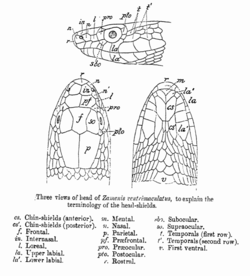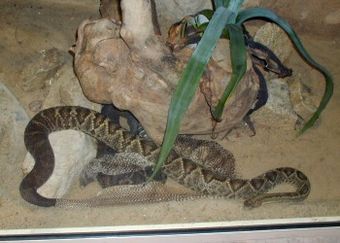
Reptile scales
Encyclopedia

Reptile
Reptiles are members of a class of air-breathing, ectothermic vertebrates which are characterized by laying shelled eggs , and having skin covered in scales and/or scutes. They are tetrapods, either having four limbs or being descended from four-limbed ancestors...
skin is covered with scutes or scales
Scale (zoology)
In most biological nomenclature, a scale is a small rigid plate that grows out of an animal's skin to provide protection. In lepidopteran species, scales are plates on the surface of the insect wing, and provide coloration...
which, along with other characteristics, distinguish reptiles from animals of other classes (except fish). Scales are made of keratin
Keratin
Keratin refers to a family of fibrous structural proteins. Keratin is the key of structural material making up the outer layer of human skin. It is also the key structural component of hair and nails...
and are formed from the epidermis. They may be ossified or tubercular, as in the case of lizard
Lizard
Lizards are a widespread group of squamate reptiles, with nearly 3800 species, ranging across all continents except Antarctica as well as most oceanic island chains...
s, or modified elaborately, as in the case of snake
Snake
Snakes are elongate, legless, carnivorous reptiles of the suborder Serpentes that can be distinguished from legless lizards by their lack of eyelids and external ears. Like all squamates, snakes are ectothermic, amniote vertebrates covered in overlapping scales...
s.
Lizard scales
LizardLizard
Lizards are a widespread group of squamate reptiles, with nearly 3800 species, ranging across all continents except Antarctica as well as most oceanic island chains...
scales vary in form from tubercular
Tubercle
A tubercle is generally a wart-like projection, but it has slightly different meaning depending on which family of plants or animals it is used to refer to....
to platelike, or imbricate (overlapping). These scales, which on the surface are composed of horny (keratinized) epidermis may have bony plates underlying them; these plates are called osteoderms. Lizard scales may differ strongly in form on different parts of the lizard and are often of use in taxonomically differentiating species.
Snake scales

Snakes are entirely covered with scales or scutes of various shapes and sizes. Scales protect the body of the snake, aid it in locomotion, allow moisture to be retained within and give simple or complex colouration patterns which help in camouflage and anti-predator display. In some snakes, scales have been modified over time to serve other functions such as 'eyelash' fringes, and protective covers for the eyes with the most distinctive modification being the rattle of the North America
North America
North America is a continent wholly within the Northern Hemisphere and almost wholly within the Western Hemisphere. It is also considered a northern subcontinent of the Americas...
n rattlesnake
Rattlesnake
Rattlesnakes are a group of venomous snakes of the genera Crotalus and Sistrurus of the subfamily Crotalinae . There are 32 known species of rattlesnake, with between 65-70 subspecies, all native to the Americas, ranging from southern Alberta and southern British Columbia in Canada to Central...
s. Snakes periodically moult
Ecdysis
Ecdysis is the moulting of the cuticula in many invertebrates. This process of moulting is the defining feature of the clade Ecdysozoa, comprising the arthropods, nematodes, velvet worms, horsehair worms, rotifers, tardigrades and Cephalorhyncha...
their scaly skins and acquire new ones. This permits replacement of old worn out skin, disposal of parasites and is thought to allow the snake to grow. The shape and arrangement of scales is used to identify snake species.
The shape and number of scales on the head, back and belly are characteristic to family, genus and species. Scales have a nomenclature analogous to the position on the body. In "advanced" (Caenophidian) snakes, the broad belly scales and rows of dorsal scales correspond to the vertebrae, allowing scientists to count the vertebrae without dissection
Dissection
Dissection is usually the process of disassembling and observing something to determine its internal structure and as an aid to discerning the functions and relationships of its components....
.
Scutes
In crocodiles and turtles, the dermal armour is formed from the deeper dermisDermis
The dermis is a layer of skin between the epidermis and subcutaneous tissues, and is composed of two layers, the papillary and reticular dermis...
rather than the epidermis, and do not form the same sort of overlapping structure as snake scales. These dermal scales are more properly called scutes. Similar dermal scutes are found in the feet of birds and tails of some mammals, and are believed to be the primitive form of dermal armour in reptiles.
Ecdysis

Ecdysis
Ecdysis is the moulting of the cuticula in many invertebrates. This process of moulting is the defining feature of the clade Ecdysozoa, comprising the arthropods, nematodes, velvet worms, horsehair worms, rotifers, tardigrades and Cephalorhyncha...
, or, in normal usage moult
Moult
In biology, moulting or molting , also known as sloughing, shedding, or for some species, ecdysis, is the manner in which an animal routinely casts off a part of its body , either at specific times of year, or at specific points in its life cycle.Moulting can involve the epidermis , pelage...
ing or sloughing.
Moult
Moult
In biology, moulting or molting , also known as sloughing, shedding, or for some species, ecdysis, is the manner in which an animal routinely casts off a part of its body , either at specific times of year, or at specific points in its life cycle.Moulting can involve the epidermis , pelage...
ing serves a number of functions - first, the old and worn skin is replaced; second, it helps get rid of parasites such as mites and ticks. Renewal of the skin by moult
Moult
In biology, moulting or molting , also known as sloughing, shedding, or for some species, ecdysis, is the manner in which an animal routinely casts off a part of its body , either at specific times of year, or at specific points in its life cycle.Moulting can involve the epidermis , pelage...
ing is supposed to allow growth in some animals such as insects, however this view has been disputed in the case of snakes.
In the case of lizards, this coating is shed periodically, usually coming off in flakes, but in some cases, such as lizards having elongated bodies, in a single piece. Some gecko
Gecko
Geckos are lizards belonging to the infraorder Gekkota, found in warm climates throughout the world. They range from 1.6 cm to 60 cm....
s will eat their own shed skin.
In the case of snakes, the complete outer layer of skin is shed in one layer. Snake scales are not discrete but extensions of the epidermis hence they are not shed separately, but are ejected as a complete contiguous outer layer of skin during each moult
Moult
In biology, moulting or molting , also known as sloughing, shedding, or for some species, ecdysis, is the manner in which an animal routinely casts off a part of its body , either at specific times of year, or at specific points in its life cycle.Moulting can involve the epidermis , pelage...
, akin to a sock being turned inside out. Moulting is repeated periodically throughout a snake's life. Before a moult, the snake stops eating and often hides or moves to a safe place. Just prior to shedding, the skin becomes dull and dry looking and the eyes become cloudy or blue-colored. The old skin breaks near the mouth and the snake wriggles out, aided by rubbing against rough surfaces. In many cases the cast skin peels backward over the body from head to tail, in one piece like an old sock. A new, larger, and brighter layer of skin has formed underneath.
An older snake may shed its skin only once or twice a year, but a younger, still-growing snake, may shed up to four times a year.
See also
- Anatomical terms of locationAnatomical terms of locationStandard anatomical terms of location are designations employed in science that deal with the anatomy of animals to avoid ambiguities that might otherwise arise. They are not language-specific, and thus require no translation...
- EcdysisEcdysisEcdysis is the moulting of the cuticula in many invertebrates. This process of moulting is the defining feature of the clade Ecdysozoa, comprising the arthropods, nematodes, velvet worms, horsehair worms, rotifers, tardigrades and Cephalorhyncha...
- MoultMoultIn biology, moulting or molting , also known as sloughing, shedding, or for some species, ecdysis, is the manner in which an animal routinely casts off a part of its body , either at specific times of year, or at specific points in its life cycle.Moulting can involve the epidermis , pelage...
- ReptileReptileReptiles are members of a class of air-breathing, ectothermic vertebrates which are characterized by laying shelled eggs , and having skin covered in scales and/or scutes. They are tetrapods, either having four limbs or being descended from four-limbed ancestors...
- Scale (zoology)Scale (zoology)In most biological nomenclature, a scale is a small rigid plate that grows out of an animal's skin to provide protection. In lepidopteran species, scales are plates on the surface of the insect wing, and provide coloration...
- Snake scalesSnake scalesSnakes, like other reptiles, have a skin covered in scales. Snakes are entirely covered with scales or scutes of various shapes and sizes. Scales protect the body of the snake, aid it in locomotion, allow moisture to be retained within, alter the surface characteristics such as roughness to aid in...

